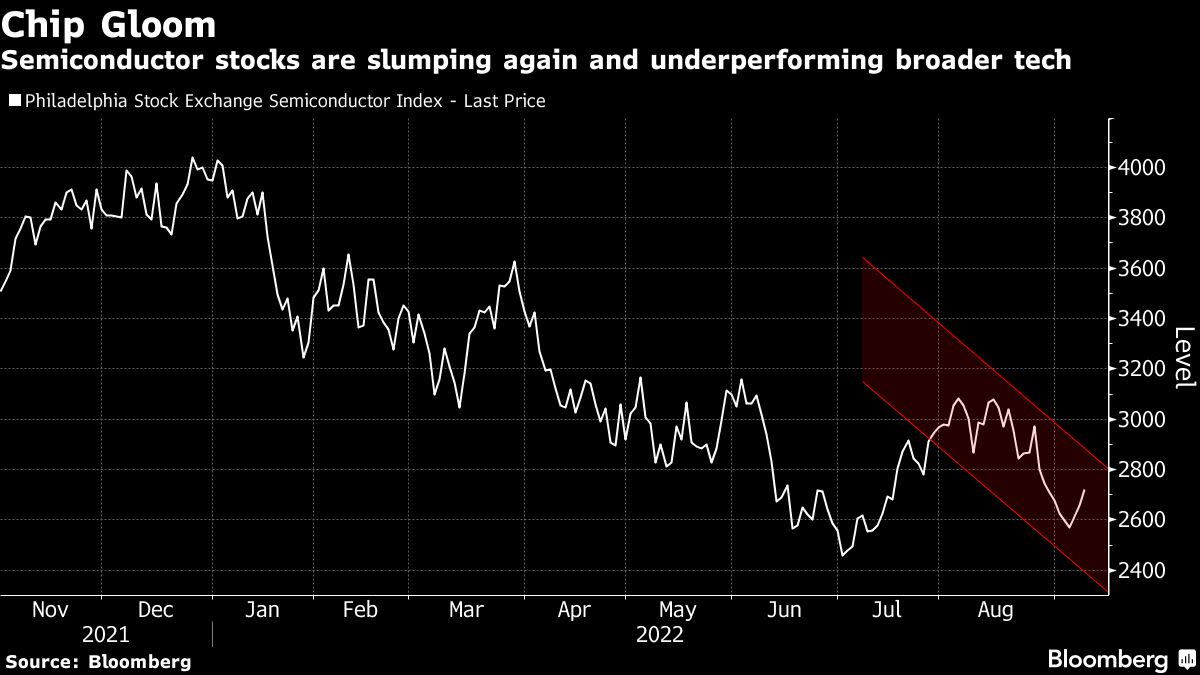
(Bloomberg) — Technology stocks are treading on shaky ground despite this week’s rally, as chipmakers signal more trouble may be ahead in an industry notorious for its booms and busts.
Semiconductor shares have been tumbling amid a series of corporate warnings about slowing demand for chips that are used in an array of electronic devices like mobile phones. The Philadelphia semiconductor index is down 11% over the past four weeks, underperforming the 7% drop in the Nasdaq 100, with laggards such as Nvidia Corp. hitting lows for 2022.
Investors are concerned slowing orders that are already plaguing makers of memory chips and other components used in personal computers could spread to the rest of the semiconductor industry. Nothwithstanding the Nasdaq 100 Index’s 4% rebound this week, technology stocks were already pressured from a Federal Reserve bent on aggressive rate hikes to snuff out inflation.
“There’s a palpable fear that the semiconductor cycle has begun to turn negative and demand is slowing,” said Jason Benowitz, senior portfolio manager at Roosevelt Investment Group. “If the downturn turns out to be deeper and longer and more broad, then we would expect technology to also underperform.”
The selloff since mid-August is a reversal from two months ago when tech stocks led a rebound in the S&P 500 amid optimism that inflation was waning, a scenario that traders believed would give the Fed flexibility to slow its campaign of interest rate increases. That optimism was squelched on Aug. 26 by central bank chief Jerome Powell, who pushed back against the idea that it would soon reverse course.
Samsung Electronics Co. added to concerns this week after a senior executive at the world’s largest chipmaker said the outlook for the second half of the year is gloomy and it isn’t seeing momentum for a recovery in 2023. That followed weak sales forecasts from companies such as Micron Technology Inc. and Western Digital Corp.
Semiconductors take months to go through a complicated manufacturing process and chip buyers are acutely concerned about a recurrence of supply chain shortages that arose after the Covid-19 pandemic caused demand to soar, making the industry’s orders an indicator of future demand for electronics and other goods.
Nvidia, which makes graphics processors used in personal computers and data centers, has lost more than half of its market value this year amid a rout in stocks with lofty valuations. The stock, however, remains a favorite for retail investors who have made more than $600 million in net purchases over the past two weeks, research firm Vanda said Wednesday.
Shrinking Estimates
Analysts have slashed profit estimates for semiconductor companies more than other parts of the tech sector. Earnings for chip-related companies in the S&P 500 are projected to be flat in 2023, down from expectations of 12% growth just three months ago, according to data compiled by Bloomberg Intelligence. By contrast, profits for the broader information technology sector are projected to expand 6%, down from 11% over the same span.
Morgan Stanley analyst Joseph Moore said this week he sees increasing challenges for chipmakers with inventories on the rise.
“We expect every sector to show some degree of inventory correction in the next 12-18 months,” he wrote in a research note, referring to the semiconductor industry.
Bullish investors argue that most of the bad news is already priced into the stocks, creating an opportunity to buy chipmakers at depressed valuations. The chip index is priced at 15 times earnings projected over the next 12 months, down from a high of 24 in January 2021 and below the average of 16 over the past decade.
However, the last time the Fed embarked on a similar rate-raising campaign in 2018, causing technology stocks to crater, the Philadelphia semiconductor index didn’t bottom out until the multiple hit 11.
Citigroup Inc.’s Christopher Danely sees parallels with a semiconductor slump about a decade ago.
“We remain cautious on semis and believe this downturn is similar to the 2011/2012 downturn, due to multiple contraction, demand contraction and inventory correction,” he said.
©2022 Bloomberg L.P.